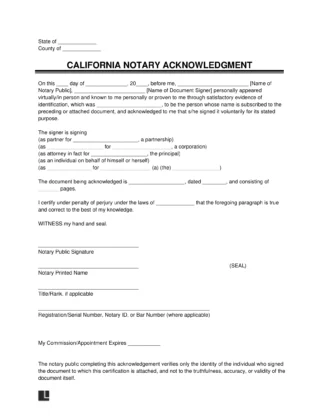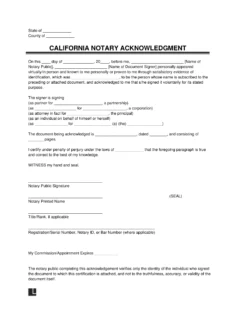

A California notary acknowledgment form validates the authenticity of signatures on legal papers. This certificate validates the voluntary execution of the document and ensures that the notary properly identifies the individuals who sign it. It is recommended that signers add their signatures before the notary public instead of presenting a pre-signed document.
Moreover, the form must include the venue where the acknowledgment takes place (usually the county), the date when the notary’s commission expires, the notary’s signature, and their official seal. This document is essential for real estate documents, contracts, and legal paperwork, adding an official stamp of authenticity to ensure the document’s validity.
Form of Acknowledgment: According to Cal. Civ. Code § 1189, the acknowledgment must be in writing and include specific language in the form, as well as names, signatures of those involved, and a notary seal.
Notary Term of Commission: Four years (Cal. Gov. Code § 8204).
Notary Handbook: The Notary Public Handbook is a valuable guide for all information related to commissioned officers.
Yes, pursuant to Cal. Gov. Code § 8231.4, starting with January 1, 2024, online notarization is now legal in the state.
In addition, California recognizes online notarizations that are properly performed by notaries of other states.
Residents can expect to pay a fee of $30 for each signature taken, which includes the electronic seal and the electronic notarial certificate (Cal. Gov. Code § 8231.9).
To obtain an acknowledgment form notarized in the state, residents have various options to locate a notary public.
You may visit a bank or credit union (Wells Fargo, for instance). UPS Stores or private notary services also provide accessible venues for notarization.
According to the Government Code Section 8211, notaries are allowed to charge below the standard $15 fee per notarized signature. They may also impose an extra fee for travel, which is not subject to specific regulations and should be openly disclosed.
Moreover, a notary public retains the discretion to waive both travel fees and standard notary charges for particular situations, such as when providing photocopies of notary journal pages.
Upon choosing a notary public, all signers should appear in front of the notary in person, presenting the original document for notarization, which should be fully completed except for signature fields.
In cases where an acknowledgment is required, signatures may already be present in the document.
Every signer must provide identification during the notarization process. One valid method is through the notary’s personal recognition of the signer. This can be based on previous interactions or knowledge of the individual.
Every signer must complete the appropriate fields in the document while in the presence of the notary public. If signatures are already present on the form, all involved parties must confirm to the notary that they have signed the document voluntarily (only relevant for acknowledgments).
Once the notary has received the required declarations and confirmed the identity of each signer, they can proceed to sign, date, and affix their seal to the relevant notarial certificate.

Create your California Notary Acknowledgment in Minutes!